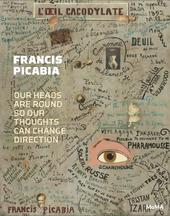
|
Francis Picabia: Our Heads Are Round so Our Thoughts Can Change Direction
Hardback
Main Details
Description
Among the great modern artists of the past century, Picabia is one of the most elusive, given his extreme eclecticism and persistent acts of self-contradiction. Though known as a Dadaist, Picabia's ongoing stylistic shifts, from Impressionism to radical abstraction, from mechanical imagery to pseudo-classicism, and from photo-based realism to art informel remain to be assessed in depth. Similarly, the breadth of his practice, which encompassed poetry, film and performance is under-recognized. Each makes him a figure relevant for contemporary artists, while the career as a whole challenges familiar narratives of modernism. Francis Picabia presents over 100 paintings, complemented by works on paper, publications, and film. Featuring some 500 illustrations and 14 essays, it examines the full range of Picabia's oeuvre. Authors including the exhibition curators, Anne Umland and Catherine Hug, distinguished professors George Baker, Briony Fer, and David Joselit, and renowned Picabia scholars Carole Boulbes and Arnauld Pierre discuss a varied series of topics, including the corporeal character of Picabia's abstractions, his unexpected turn to mechanical painting, his experiments with materials and source imagery, the problems of his politics, and his contemporary legacy. A richly illustrated chronology details the expanded nature of Picabia's visual production - from press polemics to party organizing.
Author Biography
Anne Umland is the Blanchette Hooker Rockefeller Curator of Painting and Sculpture at the Museum of Modern Art, New York. Catherine Hug is Curator, 20th Century Art at the Kunsthaus Zurich, Switzerland.
Reviews...comprehensive and sumptuous...--Alfred Brendel "The New York Review of Books" ...presents the full range of Picabia's practice--as a painter, a poet, a letter writer, a party planner, and (not least) an insatiable gadabout--but more than that, it definitively establishes him as one of the key artists of the past 100 years, a figure whose influence, at once comic and manic and dark, continues to reverberate.--Andrew Russeth "Art News" ...A sort of hero for postmodernism...--Deborah Solomon "WNYC News" ..not many historical figures have seemed as ripe [as Picabia] not only for reevaluation, but simply to have her or his work seen fully.--Sanford Schwartz "The New York Review of Books" absurdly delightful paintings.--Robert Pincus-Witten "Artforum" crackles with immediacy, popping free of its time to wink at the present--Peter Schjeldahl "The New Yorker" A leading light of the Dada movement... visually anticipating the Pop, Conceptual and Postmodern art movements--Paul Laster "CULTURED" An avant-gardist par excellence...chameleonic...--Andrea K. Scott "The New Yorker" Experimenting first with Impressionism, then Pointillism, and then Cubism and Dada, Francis Picabia (1879-1953) made himself impossible to categorize.-- "Art News" Francis Picabia: abrupt changes, wild jumps, adventurous curves... finally, an endeavor aimed at revealing the whole Picabia.--Sabine Altorfer "Aargauerzeitung" From his earliest Impressionist efforts, through Cubist, Dadaist, Surrealist and realist work... Picabia shifted fluidly with the cultural moment, all the while vigorously denouncing the style he'd just left behind...With copious illustrations and 16 essays, this hefty catalog for the current retrospective at the Museum of Modern Art attempts to chart a zigzag career that made up in energy what it lacked in depth of exploration.--Albert Mobilio "The New York Times" Picabia found the right container for his instincts. Those paintings make me deliriously happy; they sing. It's amazing they exist.--David Salle "The Art Newspaper" Picabia's fundamental comportment or attitude of refusal--of ironic negation--was the constant running through the early and late work, just as it was the constant running through his life...underneath this apparent indifference is the unmistakable echo of a reflexive negation, the constant assertion of a "no" resounding in a self-chosen void.--Daniel Barbiero "Arteidolia" Picabia's wit, use of language and found imagery, adn his style changes, make him a precursor not just of Pop Art but of Post-Modernist painting.--Roberta Smith "The New York Times" The idiosyncratic French artist was an outlier on the royal road of 20th century modernism, and an interesting one.-- "Time Magazine" The pluralist of pluralists produced some masterpieces and more unbelievably ugly paintings than any other artist in the twentieth century - besting even Sigmar Polke and Martin Kippenberger - and I cannot stop myself from loving them all.--Daniel Birnbaum "Artforum, Best of 2016" The French avant-garde artist's work was prescient about our era of 'post-truth' politics and culture.... He specializes in disinformation and is the early Modernist embodiment of 'post-truth'.--Kenneth Goldsmith "The Art Newspaper" The 10 Best Art Books of 2016--Rachel Corbett "New York Magazine"
|